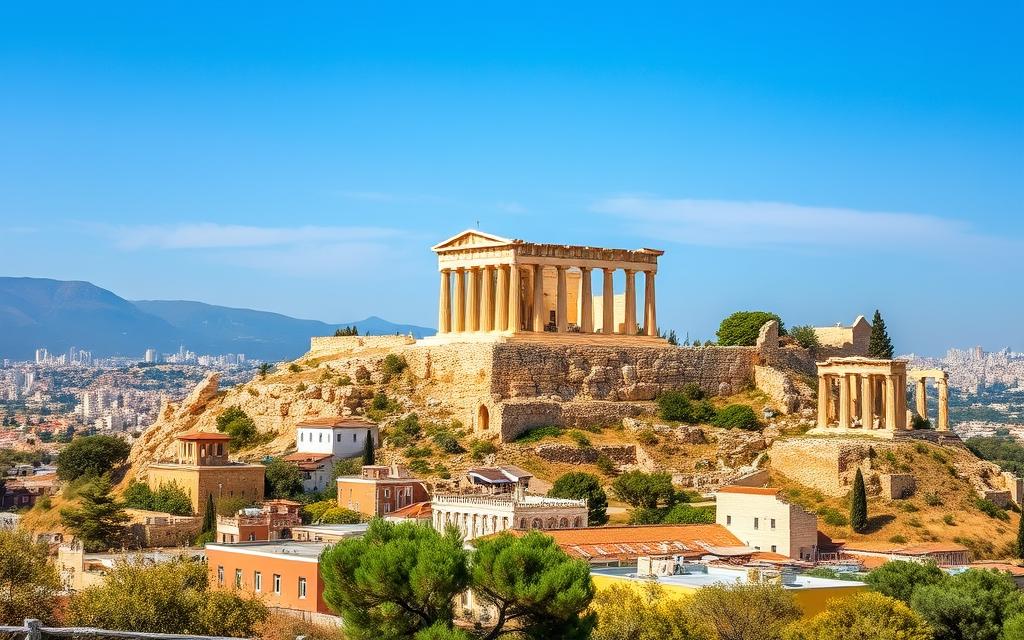The Acropolis sits high above Athens, showing off ancient Greek greatness. It was first home to people around 5,000 B.C. This place has been a spiritual, democratic, artistic, and architectural hub for thousands of years. What secrets and wonders hide within the Acropolis? What captivating stories do its iconic landmarks have to tell?
Get ready to travel back in time at the Acropolis of Athens, a UNESCO World Heritage site. It draws visitors from all over. You’ll see the stunning Parthenon and the mysterious Erechtheion. Each ruin and monument tells a piece of ancient Athens’ history and culture.
The Parthenon: The Iconic Marvel of Ancient Greek Architecture
The Parthenon sits atop the Acropolis, showing off ancient Greece’s architectural brilliance. Built from 447 to 438 BCE, it honors Athena, Athens’ goddess. It’s a masterpiece of the classical style, with 136 Doric columns that bring order and beauty.
Once, it had a roof of shiny marble tiles. But time has worn it down. Still, the Parthenon’s ruins amaze and inspire people everywhere. They give us a peek into ancient Greek art and culture.
Architectural Refinements of the Parthenon
The Parthenon’s design is a marvel of ancient Greek architects. They used smart techniques to make it look good and strong. These include:
- Upward curve of the base, called entasis, to fight the illusion of sagging
- Subtle curve of the columns, also entasis, to make them seem taller and stronger
- Thicker corner columns to balance the thinning effect of their position
These smart moves, along with its size and beauty, make the Parthenon a symbol of the Classical Greek Style. It’s a shining example of Architectural Marvels from Ancient Greek times.

“The Parthenon, in its perfection, is the culmination of the architectural genius of ancient Greece.”
Top Tourist Attractions Acropolis of Athens, Greece
The Acropolis of Athens is more than just the famous Parthenon. It’s filled with other treasures that draw visitors from everywhere. The Erechtheion is a key spot, telling the story of Athena and Poseidon‘s mythological battle for Athens’ love. It has two temples, one for each god, showing their peace after the contest.
The Porch of the Caryatids
The Porch of the Caryatids is a standout at the Erechtheion. It features six marble maidens as columns. These sculptures are a masterpiece of ancient Greek art and architecture.
Temple of Athena Nike
The Temple of Athena Nike is another must-see. It’s a beautiful temple dedicated to Athena, the Goddess of Victory. Its detailed carvings and views give a peek into the Acropolis’s ancient importance.
Theater of Dionysus
The Theater of Dionysus is on the Acropolis’s slopes. It’s the oldest and largest theater in ancient Greece. It hosted famous plays by Aeschylus, Sophocles, and Euripides.

The ancient Greek ruins on the Acropolis still amaze and inspire people today. They give a glimpse into Athens’ rich history and culture.
| Attraction | Highlights | Fun Fact |
|---|---|---|
| Erechtheion | Mythological competition between Athena and Poseidon, Porch of the Caryatids | The Erechtheion has stood for over 3,300 years on the Acropolis. |
| Temple of Athena Nike | Elegant, well-preserved temple dedicated to the Goddess Athena | The temple offers stunning views of the Acropolis and the city of Athens. |
| Theater of Dionysus | Largest public meeting space in ancient Athens, hosted famous playwrights | The theater remains in use today, hosting cultural events and performances. |
The Propylaia: The Magnificent Entrance to the Acropolis
The ancient city of Athens was truly a marvel. The Acropolis, its highest point, needed an entrance that matched its splendor. The Propylaia, a grand staircase of columns, was that entrance. It welcomed visitors and prepared them for the stunning Parthenon and other monumental temples.
Between 437 and 432 BC, the Propylaia was built as part of the Periklean Building Program. The famous Athenian architect, Mnesikles, designed it. The plan included five halls, but the project was halted in 432 BC.
Even unfinished, the Propylaia showed the beauty of ancient Greek architecture. It had no sculptures, focusing on its columns and design. Later, the Beulé Gate was added, using parts from another monument.
Over time, the Propylaia changed roles. It was used as a storage place and even a church. Restoration began after the Turkish left, with big work done from 1909-1917.
Now, the Propylaia is a symbol of ancient Greece’s architectural skill. It welcomes visitors to the Acropolis, showing the city’s deep history and culture.
Odeon of Herodes Atticus: An Ancient Open-Air Theater
The Odeon of Herodes Atticus is at the base of the Acropolis. It’s a great example of ancient Greek theater design. It was built in AD 161 by Herodes Atticus for his wife, Aspasia Annia Regilla.
This Odeon of Herodes Atticus could hold up to 5,000 people. It had a marble floor and a big stage. The seats were on 32 rows of marble benches.
In 267 AD, it was damaged. But in the 1950s, it was fixed. Now, it’s a famous Athens landmark for performing arts in summer.
It has seen famous acts like Maria Callas and Luciano Pavarotti. It’s also where Sylvie Guillem danced. The Odeon of Herodes Atticus is key for the Athens Festival.
“The Odeon of Herodes Atticus is a breathtaking example of how ancient Greek architecture and modern performance can coexist in perfect harmony.”
– Edith Hamilton, renowned author and historian
The Erechtheion: A Monument to Greek Mythology
The Erechtheion is a key part of the Acropolis of Athens. It was built between 421 and 406 BC. It tells the story of Athena and Poseidon’s battle for Athens’ love.
The temple has two parts, one for Athena and one for Poseidon. This shows their peace after their contest. The Porch of the Caryatids is famous. It has six female figures that hold up the roof.
The Erechtheion has faced many challenges over the years. It has survived fires, natural disasters, and political changes. It shows the lasting impact of Greek mythology and ancient Greek skill. Now, it’s a top spot for those visiting the Acropolis of Athens.
Source Links
- https://thetourguy.com/travel-blog/greece/athens/acropolis/top-things-to-see-at-the-acropolis-this-year/
- https://www.planetware.com/athens/acropolis-gr-ath-acrop.htm
- https://www.britannica.com/topic/Parthenon
- https://www.greeka.com/attica/athens/sightseeing/acropolis/
- https://www.encounterstravel.com/blog/parthenon-in-athens
- http://www.inspirationtravel.com/blog/athens-travel-guide-top-attractions
- https://www.lonelyplanet.com/greece/athens/attractions
- https://en.wikipedia.org/wiki/Propylaia_(Acropolis_of_Athens)
- https://whc.unesco.org/en/list/404/
- https://www.aroundgreece.net/athens/acropolis/propylaea
- https://en.wikipedia.org/wiki/Odeon_of_Herodes_Atticus
- https://www.greeka.com/attica/athens/sightseeing/athens-herodion-theatre/
- https://en.wikipedia.org/wiki/Erechtheion
- https://acropolisdeatenas.info/en/acropolis-of-athens/erechtheion/
- https://www.athenstourgreece.com/the-erechtheion/

